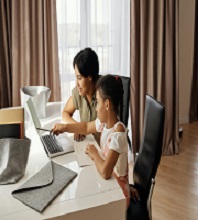Online therapy services or Telehealth Services have many benefits:
- Allows the therapist to touch base with you regularly, and can help to come up with a therapy plan during this time of distancing.
- Allows the therapist to provide education and home activities for the parents to support continued progress towards your child’s therapy goals.
- Allow the virtual sessions to be tailored depending on each child/family and their current needs.
If you are interested in finding out more about telehealth or scheduling an appointment by calling us at 778-395-8752. We are doing our best to make sure we help each child will continue to reach their developmental goals!

WHAT IS TELEHEALTH?
Telehealth therapy is simply therapy that takes place online. During a Telehealth session, your therapist will use a secure online video conferencing session as a tool to provide therapy. One of the huge benefits of virtual sessions during this time is that we can continue to provide therapy services while you are in the safety of your home.
WHAT WILL A TELEHEALTH SESSION BE LIKE COMPARED TO AN IN-CLINIC SESSION?
Virtual sessions will look a little different than your usual clinic-based sessions. Therapists will tailor each session based on your child’s needs and interests and will take advantage of the materials that you have in your home.
The great thing about telehealth sessions is that it gives the opportunity for parents to participate more in each therapy session!
HOW DO I LOG ON TO MY TELEHEALTH SESSION?
After your request for Telehealth services, your child’s therapists will provide you with a secure telehealth link. Logging on is as simple as opening the link in a Firefox or Chrome browser. The program will then ask you for permission to access your camera and microphone so that the therapist is able to see and hear you and your child.
We recommend opening the shared link prior to your first session. This will allow you to check that it opens on your current web browser and hopefully work out any kinks before the session begins.
If you are having trouble with connection speed try turning off all streaming services during the session (such as Netflix, or any gaming platforms). If you have any questions prior to starting, feel free to reach out to your therapist or email us at info@symbiosispediatrictherapy.com
DO I NEED TO PREPARE ANY MATERIALS FOR THE SESSION?
Your child’s therapist will communicate via email to check what materials and toys you have at home. They may ask you to print specific worksheets, have household materials like pillows or chairs ready for an obstacle course, etc. If you do not have access to a printer, that is OK! Our therapist will ask you for a list of other items that can be used for gross or fine-motor activities or exercises. Don’t worry, we can get creative with what you have available at home!
WHAT IF MY CHILD HAS TROUBLE PAYING ATTENTION?
To help minimize distractions, we recommend clearing the area of as many toys or distractions as possible before the session and turning off any distracting noises (TVs or music). Your therapist will work with you to help create a session that keeps your child engaged and keep the session fun. Some children may benefit from movement breaks to help with attention during the session.
Most importantly, remember that these sessions are not only about the child, but also an opportunity for parent-therapist communication. Even if your child has trouble participating through an entire virtual session, this is an excellent opportunity for the therapist to help you develop an at-home therapy plan for between sessions. With a successful home carryover plan in place we can work together as a team to help your child meet their goals!
CAN MY OTHER CHILDREN BE PRESENT DURING MY CHILD’S SESSION?
We prefer that other children are not present during an initial session to eliminate distractions. Once our therapist has established a rapport over the video, therapists may request that a sibling that is able to follow simple directions is present to help with activity motivation or partner work. This will vary depending on each child/family, and your treating therapist will work with you to help determine the best option for your child. It is important to note that children who are not related to the child receiving therapy cannot be present in order to maintain patient privacy.












